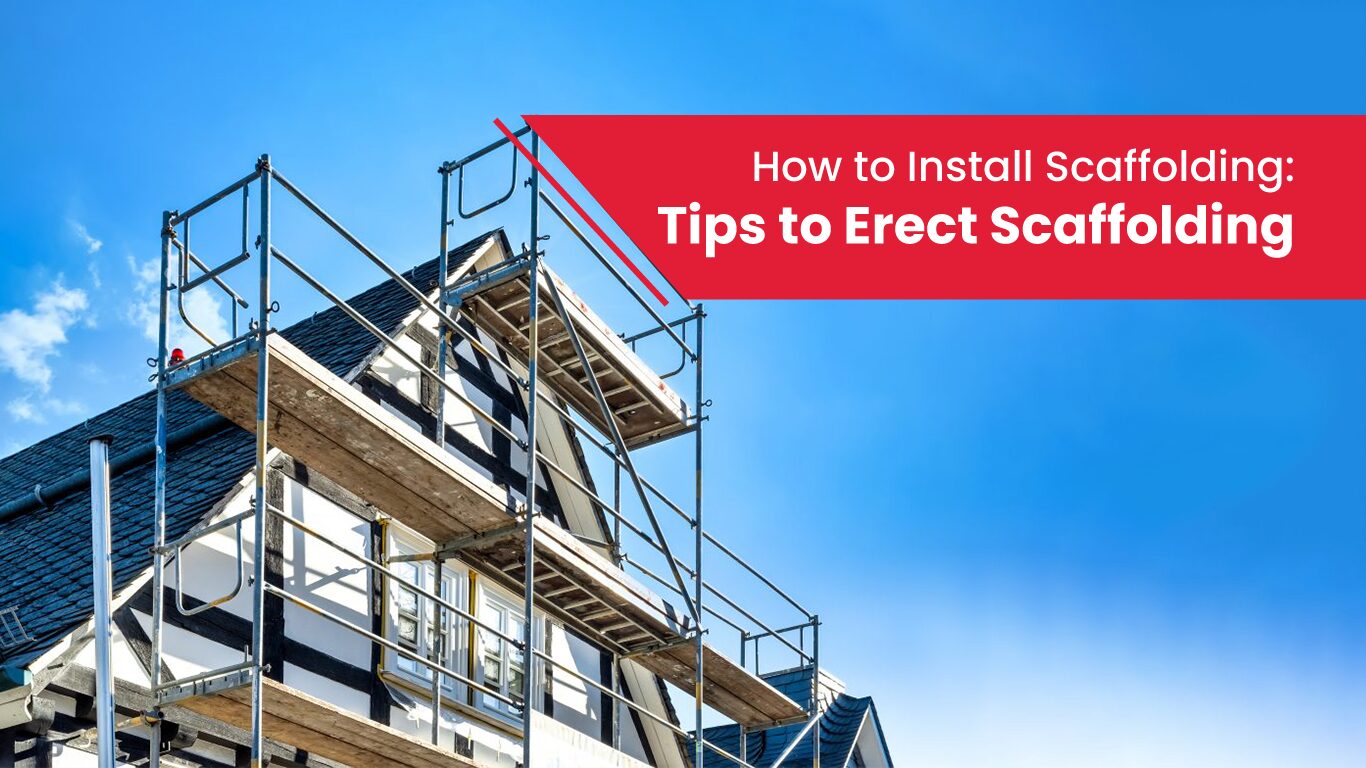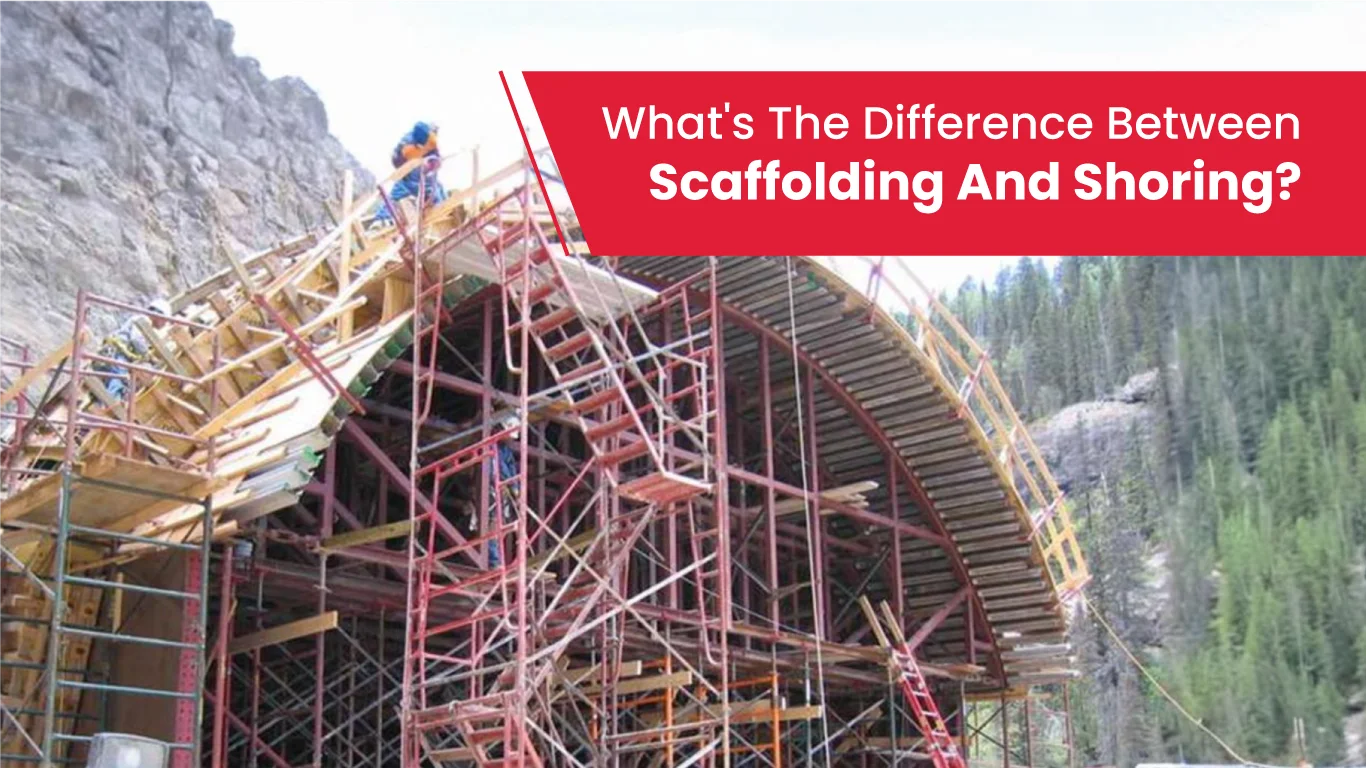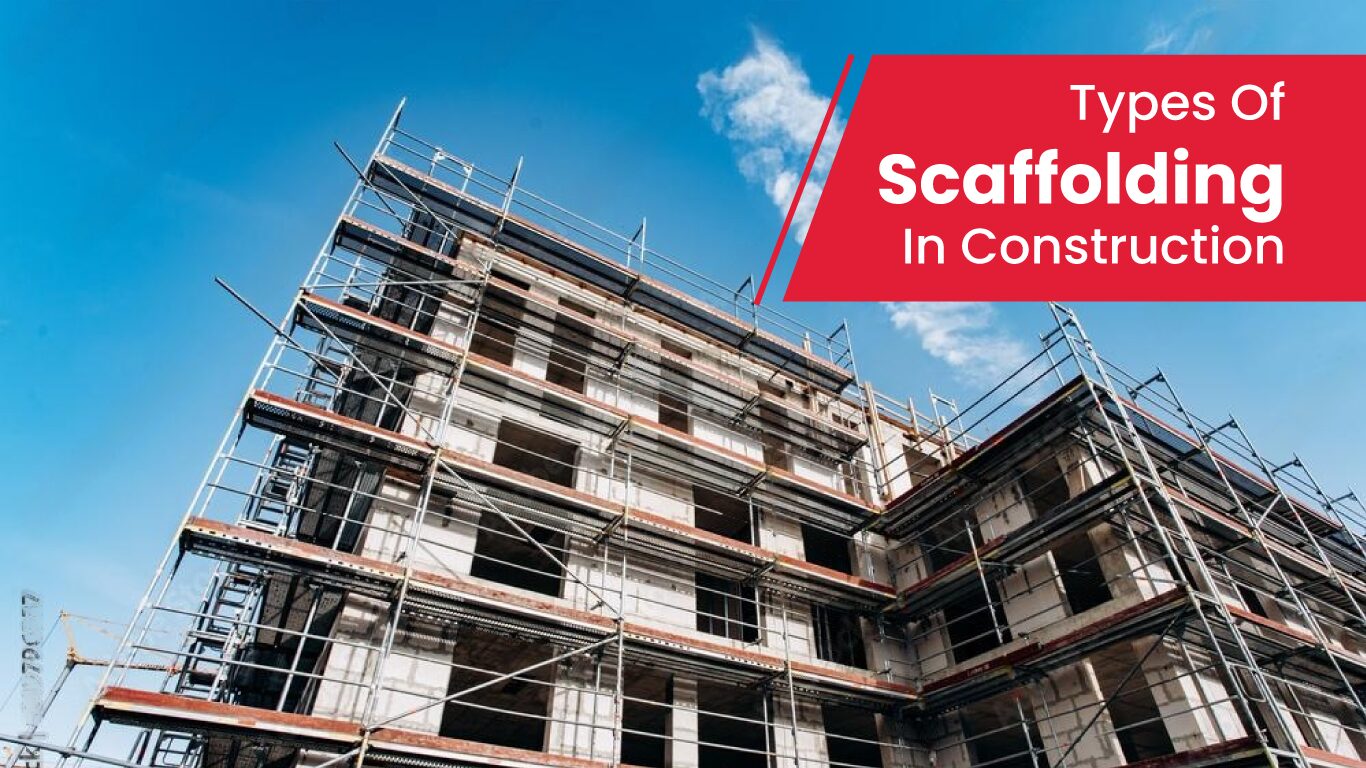How to Install Scaffolding: Tips to Erect Scaffolding
Comments Off on How to Install Scaffolding: Tips to Erect ScaffoldingIn the realm of construction, it’s always important to set up a scaffold properly. Once installed, the scaffold offers a stable platform for the workers to perform different tasks. Way ahead, when the scaffold is adjusted, it can allow the workers to reach hard-to-access places. But, do you actually know the steps for erecting a scaffold? Well, if you don’t know how to get started, then scroll through the article. As you read ahead, you will know more about scaffolding installation.
1-Selecting a suitable scaffold
Choosing the right type of scaffolding is important to ensure scaffold safety. The structure should also be selected for maximum efficiency. So, to help you decide, here are some scaffolds ideal for diverse projects.
Supported Scaffolds increase
Such scaffolds are used for every type of project. Apart from building maintenance, these can be used for new construction projects. While the entire structure is built with horizontal and vertical columns, it offers scaffold platform stability. These also offer support when bridges are undergoing repairs. In factories, this scaffolding also allows crews to inspect structural elements.
Suspended Scaffolds increase
Most of the time, contractors use suspended scaffolds for large structures. A hoist system is used for the scaffolding installation. Once erected, this scaffold enables workers to move freely across different sections. Moreover, these are useful when there’s a need for a stable platform at heights. They are also commonly used for installing or cleaning windows on tall buildings.
Cantilever Scaffolds
These scaffolds have poles that can be fixed firmly to the walls. Hence, it offers support for accessing materials beyond the wall edge. You may come across this scaffold when tasks are performed on sloped surfaces. Cantilever scaffolds are also ideal for accessing the facades of buildings. This structure is used for tasks like repairing, cleaning, or painting the exterior. Individuals can also work at the upper levels of the building once the scaffold is set up.
2-Obtaining the Necessary Permits
Before you proceed with scaffolding installation, it’s important to procure permits. In such a case, you have to present an application for building permits for scaffolding. This document will depend on the location and what kind of scaffold needs to be set up. Moreover, it’s also important to ensure to stay compliant with certain regulations. The structure is also determined by what type of access workers need. But, to confirm whether the scaffold has met the standards, you should get in touch with an expert.
3-Assembling the Scaffold
- Once the contractor decides to erect the scaffold, the base has to be initially laid.
- Usually, workers use metal braces to connect the horizontal poles. Later, vertical columns are secured at regular intervals using bolts.
- Diagonal braces are also placed properly to make the structure sturdy.
- Workers will then place a platform over the vertical poles and secure them with brackets.
- While carrying out the above tasks, workers use a ladder. Once a ladder is used, it helps to ascend or descend the structure.
- Above all, the workers must make sure that a flat surface is supporting their motion.
- Eventually, the bolts and connectors are tightened so that the structure doesn’t collapse.
4-Setting up the Base Plates and Casters
- During this step of the scaffolding installation process, two individuals place the base plate and hammer the ground anchors.
- Soon after the base plates are laid, the castors and anchors are placed carefully. But, to ensure that the caster is locked in its position, a pin is used.
- Once the position is set, the worker checks the balance with a spirit level.
- Now, the base plates are secured with a ground anchor. It’s essential to anchor the base plates into solid surfaces. This step will not make them loose even when there’s heavy weight.
- Towards the end, the castor wheels are attached to every corner. Post securing all the corners, the vertical posts are positioned with great care.
5-Adding essential components
Adding toeboards, and guardrails along with the platforms is the next step to consider. Such parts can be bought from a reputed scaffolding equipment supplier. While these components offer stability, it enables workers to move around the structure.
- As far the platforms are concerned, they must be capable of sustaining around 300 kilos.
- Before selecting platforms, you should make sure that they aren’t cracked. In case you come across any cracks, then consider a replacement.
- Now, guardrails should be installed at a minimum height of 42 inches.
- Make sure you secure the guardrails firmly using bolts. Additionally, you may need some more guardrails while working at heights as much as 10 feet.
- Later, toe boards must be used to prevent tools from slipping off the platform’s edge. While the board has to be a minimum 4 inches high, the gaps shouldn’t be more than 1 inch.
- To ensure maximum safety, the toe boards have to be secured with bolts.
6-Performing safety checks
- Soon after scaffolding installation, the structure is inspected for stability.
- While workers check the structure, they ensure if any parts are loose or missing.
- They must also observe the parts and check whether they are corroded.
- Before disassembling the scaffold, the workers must eventually inspect as per the OSHA standards.
- As everyone proceeds with the dismantling stage, they use a ladder for inspection.
- The structural integrity must also be verified before disassembling the scaffold.
- Once individuals commence with the dismantling, they should avoid jumping to different levels.
- The workers must either ascend or descend carefully with the help of a ladder.
- Additionally, they also check if all the planks are dismantled with a minimum of three clamps per side.
- In the future, the workers will also have to ensure that guardrails are upgraded. This helps to meet the changes in regulations.
FAQ
1. How do you erect scaffolding step by step?
When you’re planning to erect the scaffold, you need to prepare the foundation. Later, you have to choose a suitable scaffold, and fix the vertical and horizontal columns. Post this step, you also need to set up the guardrails. But, before erecting the scaffold, you have to obtain permits.
2. How is scaffolding built step by step?
While you build a scaffold, you have to prepare the site, and choose a suitable scaffold. A bit later, you have to obtain permits and proceed with assembling the structure. After this, you have to add the various sections and install the base plates properly.
3. What is the 3 to 1 rule for scaffolding?
As per the 3 to 1 rule, the total height for working must be thrice the distance of the base side. But, this side of the base must be narrowest.
4. How to attach a scaffold to a building?
Many methods are used for attaching a scaffold. While some workers may use mechanical anchors, others may use compression ties. They may also move ahead with compression welding to secure the scaffold firmly.
5. How to install scaffolding for beginners?
Many steps are involved while securing a scaffold. These include assembling the parts, placing the planks, attaching the guardrails, and inspecting the temporary structure.
6. How to erect a scaffold tower?
Workers can erect a scaffold tower by first setting up the foundation. They then have to assemble the parts and also fix the guardrails. In the end, the saffold is inspected to ensure safety and stability.
Conclusion
Finally, we hope that you are now aware of how a scaffold is erected. To sum up everything, here’s what we have to say.
- These are important for maintenance and construction projects.
- They also serve as a secure platform when efficiency and safety are the prime concerns.
- Workers should also use supreme-quality equipment to prevent sudden accidents. Guidelines must also be followed so that the tasks are performed effectively.
Still searching for a leading scaffolding equipment supplier? Well, why not consider approaching AAIT Scaffolds? While we are committed to timely delivery, we never drift our focus on quality. As you plan to execute the construction project, you can source components from our inventory in Houston.
What’s the Difference Between Scaffolding and Shoring?
Comments Off on What’s the Difference Between Scaffolding and Shoring?In the construction industry, scaffolding and shoring are the different systems that ensure safety during various phases. Even when both support construction activities, they serve distinct purposes. But, you must know the difference between shoring vs scaffolding. So, to drive away the confusion, read this article to know more about the structures.
What does one mean by Scaffolding and Shoring?
In simple terms, scaffolding is a temporary structure that offers workers support to reach heights. While these create a stable platform, it enables workers to perform tasks efficiently. Individuals can also move ahead complex structures smoothly with the structure. In contrast, the main purpose of shoring is quite different.
As workers use shoring, it provides support for unstable structures. This ensures stability and supports loads that are beyond the capacity. Once set up, shoring maintains the structure’s integrity and enables people to carry out tasks efficiently. Eventually, shoring reinforces areas like foundations or walls.
What is the primary purpose of both the structures?
Now, there’s an easy way to understand the difference between shoring vs scaffolding. If the main purpose of using a platform is to stand and carry out tasks, then it’s a scaffold. But, if the formwork supports the existing structure, then it is referred to as shoring. The applications of the structures will help you understand the difference better.
For instance, if the scaffolding is used in the refinery industry, then workers can access heat exchangers, pressure vessels and more with ease. Scaffolds are also erected in the petrochemical industry for accessing hard-to-reach points in the facilities.
When shoring is used in the construction domain, it can offer the requisite support when the building is undergoing renovation. Individuals can then work on tasks to improve certain sections. Shoring can also serve as a temporary structure when a stage has to be built for an event.
Although both the temporary structures serve a certain intention, a scaffolding component can be a shoring component. On the contrary, workers may use the shoring frame as a scaffold component. They may also use a shoring tower temporarily while building a shoring system.
Which scaffolding is commonly used at sites?
While builders are looking for temporary support for the project, here are some types of scaffolding they might use.
Double Scaffolding
Such scaffolds are known as independent scaffolding. While erecting this scaffold, metallic pipes are used to connect two rows of poles. This structure is useful in stone masonry because it’s tough to drill holes in stone walls.
Cantilever scaffolding
This scaffolding is generally used when it’s not practically possible to place supports. Hence, during its installation, workers support it from one end and let the other end extend over a space. Moreover, these scaffolds are used during bridge constructions, and while maintaining the building’s facade.
Suspended scaffolding
Suspended scaffolding is yet another temporary support that hangs from a building. Such a kind of scaffold is used when workers can’t reach areas with ease. On the other hand, workers may use this scaffold when ground-based supports are not practical to set up.
Trestle scaffolding
This type of temporary support offers mobility for workers from one place to another. As these are used indoors, the tripods or movable ladders offer support. Hence, people install trestle scaffolding when they have to perform maintenance tasks.
Apart from the ones stated above, you will also come across steel scaffolding because they are strong. Contractors may also pre-assemble scaffolding when there’s less time to complete the project. Feel free to connect with a leading scaffolding equipment supplier to figure out the best scaffold.
Which shoring is commonly used at sites?
At a construction site, you may come across many shoring techniques. Let’s go through the types of shoring.
H-frame shoring
H-frame shoring consists of vertical and horizontal members forming a frame that is placed against a structure to provide support. It is commonly used in trenching and excavation to prevent the sides from collapsing. When steel I or H beams are placed firmly in the ground, workers spend time drilling them. They then support the piles once they are drilled.
Secant pile shoring
When workers consider this shoring, they form a wall. This is useful, especially when there’s insufficient space for the open excavation. While the individuals are busy, they use primary and secondary piles. They may also be involved in installing overlapping reinforced concrete piles. This creates a continuous wall to support the entire evacuation.
Contiguous pile shoring
When water seepage is not a concern, this kind of shoring is considered. In this technique, the piles are usually placed one after the other. As a result, a continuous wall is formed around the area. Apart from offering stability, the shoring prevents soil collapse during evacuation.
Sheet pile shoring
Just like H-beam shoring, sheet pile shoring has many steel beams for support. While workers start setting up the beams, they use a vibro hammer. The technique is generally employed in areas with soft soils. You will certainly come across this shoring in deep evacuations, and trenching projects.
Diaphragm walls
Under such kinds of shoring systems in construction, workers use concrete walls meant for deeper excavations. This involves the construction of tunnels, basements, and more. Moreover, the walls are formed by setting up panels one after another. The interlocking of panels offers structural stability during the construction phases.
Can scaffolding also be used as a shoring solution?
Although shoring differs from scaffolding, people use scaffolding in some cases. The structure is used instead of shoring. Individuals may use scaffolding when support is needed for structural repairs. The overall structure can also be used to support vertical elements that may collapse. In addition, scaffolding can be used to support floor slabs or add a new level.
FAQs
1. What is the difference between shoring and scaffolding?
Scaffolding always differs from shoring. While a scaffold offers access to different heights, shoring offers support for unsafe structures.
2. Can scaffolding be used as shoring?
Scaffolding can be used as shoring in some cases. But, the main difference between the two lies in configuration, purpose and the design.
3. What are the 3 types of scaffolding?
Supported, aerial and suspended scaffolding are most commonly erected at construction sites. But, such types are used for diverse purposes. But, to use a suitable scaffold, you must know more about them.
4. What is the difference between shoring and formwork?
When the construction work needs support, a formwork is erected. But, in case unsafe structures have to be supported, then shoring is established.
5. What is shoring in construction?
As workers proceed with the construction tasks, they need to support a trench, building or a structure. This technique is called shoring and it prevents the structure from collapsing.
Conclusion
Finally, you must approach a scaffolding equipment supplier if you wish to set up a scaffold. At AAIT Scaffold, we can offer scaffolding accessories and numerous equipment. While we serve our clients to meet their diverse needs, we assure utmost quality. With efficient logistics, we also make sure that the components are delivered within a time span in Medley and Houston.
Types of Scaffolding in Construction
Comments Off on Types of Scaffolding in ConstructionIn the present time, a scaffold offers a stable platform for carrying out construction tasks. The overall structure also enables workers to move across different sections. Additionally, the scaffold offers comfort while working for a pretty long time. But, are you still confused on which scaffold to use? Well, check this article to know more about the types of scaffolding in the construction sector.
Single / Brick Layer Scaffolding
Whenever a structure has to be built with bricks, a single scaffolding is used. While the scaffold is quite stable, it helps workers to do tasks at different levels. Usually, it comprises many components like ledgers, standards, and more. While the standards have to be 2 m apart, the ledgers have to be placed 1.2 m away. Additionally, the workers attach the putlogs to the ledgers. Mostly, these are placed at an interval of around 1.2 m.
Double / Independent Scaffolding
Now, when the structure has to be built using stones, then the workers will use double scaffolding. As stones are hard, it is tough to drill holes. Hence, the scaffold is made stronger with two rows of bars. The first row is always at a distance of 20 cm from the wall. But, the other row is 1 m away from the row that has already been set up. A bit later, putlogs are placed for supporting both the frames.
If you’re seeking a scaffold as per your needs, then don’t hesitate to contact a leading scaffolding equipment supplier.
Cantilever Scaffolding
During maintenance work, this kind of temporary structure is employed. In this structure, the horizontal bars are firm due to the support of cantilever beams. Moreover, workers use the scaffold when it’s hard to reach certain areas. They no longer have to bother about ground-based supports. Owing to the entire design, workers can expect less interference from people walking along a street.
Suspended scaffolding
Among the types of scaffolding, these are quite efficient when used for tasks on tall buildings. They consist of platforms suspended from overhead supports. Mechanical hoists or ropes are used to set up this scaffold. Once individuals use the structure, they can access high levels easily. As these can be adjusted, they are useful for tasks like facade repairs, painting, and window cleaning.
Ladder / Trestle scaffolding
In such a type of scaffold, the tripods support the working platform. While these are compact in nature, they are useful for less intensive tasks. Most of the time, workers erect these inside a room. They use it while painting walls or doing tasks related to repairing. As the legs can be adjusted, they can be altered based on the scenario.
Mobile Scaffolding
As you can figure out by the name, these scaffolds have wheels. Hence, workers can move the structure when there’s a need. For instance, if they have to paint many walls, then they prefer using the scaffold. Besides, it’s not complex to assemble or dismantle the structure entirely. It can also be set up at different heights.
Tube & Clamp Scaffolding
Under the types of scaffolding, these comprise couplers and tubes. These are also widely used as they can be assembled with minimal effort. The workers can also place the vertical bars in any position. So, if they want to erect an odd scaffold, then this type is ideal. The structure can be either erected for irregular buildings or within a plant. The diagonal tubes may also be used to increase stability. Workers establish a secure connection using couplers or swivel clamps.
System Scaffolding
At times, people may call these scaffolds as modular scaffolds. However, workers must make sure that they erect the scaffold in a nice way. This has to be considered because the bars are already designed.In addition, workers don’t have to be skilled in erecting this scaffold. This is because the connectors’ locations are fixed.
Cuplock scaffolding
Cuplock scaffolds are modular structures known for efficiency. These are also easier to assemble at the construction site. Once set up, the various components are connected with unique cuplock fittings. Because of this, the scaffold is quite strong. Furthermore, the modular design offers flexibility in handling diverse projects.
Kwikstage scaffolding system
Owing to their stability, these scaffolds are widely used in the construction sector. Just like cuplock scaffolding systems, these have vertical and horizontal bars. But, these differ from other types of scaffolding due to the locking system. These have V-shaped fittings in place of cup-shaped locking mechanisms. Once the ledgers fit into the exact positions, the system is secured. In addition, stability is complemented by transoms. These are used to link the outer bars with the inner ones.
Staircase Tower
Staircase towers are mainly used with an aim to use the main platform. Once you observe the scaffold type, it appears like a staircase. Therefore, workers can carry tools safely by climbing the stairs. This is a safer way than using a ladder. However, to enhance its strength, manufacturers may use special components.
Frame & Brace Scaffolding
Known as sectional scaffolding, the frame and brace scaffold is most common at sites. Apart from being versatile, the scaffold is easy to use. Most of the time, people set up this structure in one or two levels. But, because of the modular frames, these can be extended. In fact, workers can access several levels when it’s used in large-scale projects.
Mast Climbing Scaffolding
Synonymous to suspended scaffolds, these are not hung using wires. But, these are quite strong when compared to other types of scaffolding. A fixed mast structure also enables them to descend or ascend along the scaffold. Moreover, the best part is that these scaffolds can be extended to reach multiple floors. They are also useful, especially when there’s less ground area.
Shoring
Shoring systems serve as a structure to support something that’s permanently set up. This may include a bridge or a building. Primarily, the structure as well as the formwork keep liquid concrete in place. Thus, the concrete solidifies till the time it supports itself.
Other forms of scaffolds
Besides the above scaffolds, equipment is used to offer a stable platform. Such equipment is manually driven or may run on an electric current. It is quite useful for short term projects covering a small region. Under these, you will come across scissor lifts, cradle scaffolds, and more.
FAQ
1. What are the 6 types of scaffolding?
Single, double, cantilever, suspended, Kwikstage and Cuplock are the 6 types of scaffolds.
2. What are the 3 types of scaffolding?
Single, double, and suspended scaffolding are the 3 types of scaffolds.
3. What are the three basic types of scaffolds in the construction industry?
Among the various types of scaffolds, suspended, double and single scaffolding is mainly used in the construction domain.
4. What is the most common type of scaffolding?
Ringlock scaffolding is the most common type of scaffold. However, workers may use single and double scaffolds based on the intended purpose.
5. What is a class 4 scaffold?
Class 4 scaffold is normally known for sustaining heavy activities. This scaffold is useful while storing material or carrying out masonry work.
Conclusion
Finally, if you can’t decide, then you can contact AAIT Scaffold. Through the years, we have been the leading scaffolding equipment supplier in the US. Through the years, we have earned a reputation for offering reliable scaffolding solutions. While we meet diverse needs of industries, we always focus on quality.












 Download
Download

